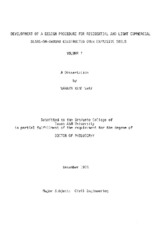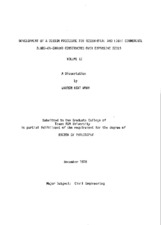| dc.contributor.advisor | Lytton, Robert L. | |
| dc.creator | Wray, Warren Kent | |
| dc.date.accessioned | 2020-08-20T19:41:24Z | |
| dc.date.available | 2020-08-20T19:41:24Z | |
| dc.date.issued | 1978 | |
| dc.identifier.uri | https://hdl.handle.net/1969.1/DISSERTATIONS-195819 | |
| dc.description | Vita. | en |
| dc.description.abstract | A computer analysis of the soil-structure interaction occurring between stiffened slabs-on-ground and expansive and compressible soils was used to determine design equations for predicting the magnitude of bending moment, shear and differential deflection expected to occur under service conditions. The investigation was conducted using a finite element analysis of a plate resting on an elastic foundation. Analysis showed the maximum design moment and shear values in either bending mode to occur near the slab edge, within a distance, β, determined by the relative stiffnesses of the slab and the soil. The moment in the short dimension was typically found to be greater than the moment in the long dimension. Analysis also showed the magnitude of the maximum moment depended on the slab length with moment reduction occurring at mid-length of the slab, the amount of which depended upon the depth of the stiffening beams. The greatest amount of differential deflection was found to occur within a distance of 6β for slabs longer than this length. An additional computer analysis was conducted to analyze the effect of post-tensioning reinforcement on differential deflection, and cracking and ultimate strength. This analysis showed positive placement of the prestressing force offered a deflection advantage to post-tensioned slabs over those without prestressing. The investigation also showed that although moment capacity is lost after exceeding the concrete tensile strength, moment capacity is recovered with increased loading due to increased soil support. Using the results of the computer analysis, a design procedure is developed that is applicable to either post-tensioned or conventionally reinforced slabs. A method of estimating the edge moisture variation distance is presented. The new procedure is compared to design methods presently available and is found to produce, in general, smaller design values of moment and differential deflection, particularly in long slabs. | en |
| dc.format.extent | 2 volumes | en |
| dc.format.medium | electronic | en |
| dc.format.mimetype | application/pdf | |
| dc.rights | This thesis was part of a retrospective digitization project authorized by the Texas A&M University Libraries. Copyright remains vested with the author(s). It is the user's responsibility to secure permission from the copyright holder(s) for re-use of the work beyond the provision of Fair Use. | en |
| dc.rights.uri | http://rightsstatements.org/vocab/InC/1.0/ | |
| dc.subject | Concrete slabs | en |
| dc.subject | Foundations | en |
| dc.subject | Swelling soils | en |
| dc.subject | Civil Engineering | en |
| dc.subject.classification | 1978 Dissertation W943 | |
| dc.subject.lcsh | Foundations | en |
| dc.subject.lcsh | Concrete slabs | en |
| dc.subject.lcsh | Swelling soils | en |
| dc.title | Development of a design procedure for residential and light commercial slabs-on-ground constructed over expansive soils | en |
| dc.type | Thesis | en |
| thesis.degree.grantor | Texas A&M University | en |
| thesis.degree.name | Doctor of Philosophy | en |
| thesis.degree.level | Doctoral | en |
| dc.type.genre | dissertations | en |
| dc.type.material | text | en |
| dc.format.digitalOrigin | reformatted digital | en |
| dc.publisher.digital | Texas A&M University. Libraries | |
| dc.identifier.oclc | 5527885 | |



